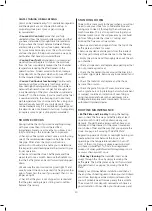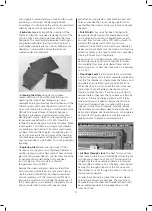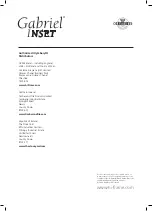
20
GLASS STAINING OR BLACKENING
Glass can be cleaned easily if it is undertaken regularly
and the deposits are not allowed to build up. A
proprietary stove glass spray or gel is strongly
recommended.
• Causes: Air Controls
Ensure that you fully
understand how the Airwash system works and that
you have determined, through some trial and error
that you have the correct balance between Primary
and Secondary air that your stove needs. Generally,
try to use more Secondary air as this air flows down
and over the glass to help burn and wash away any
particulates that have accumulated there.
• Causes: Poor fuel
Burning damp or unseasoned
wood will cause the glass to stain as the moisture
from the fuel considerably reduces the fire chamber
temperature reducing the effectiveness of the
Airwash system. ‘Green’ wood will also encourage
sticky deposits on the glass which will prove difficult
for the impaired Airwash system to remove.
• Causes: Continuous low burning
Continuously
burning your stove with a very low flame, such as
slow overnight burning will also cause this problem
because the Airwash does not get hot enough and
some blackening of the glass should be considered a
‘trade-off’. In this instance, if you’re sure that the fuel
is seasoned and dry, then burning the stove at very
high temperature for a short period after a long slow
burn will usually burn off any sooty deposits. Glass
can be cleaned easily if it is undertaken regularly and
the deposits are not allowed to build up. A proprietary
stove glass spray or gel is strongly recommended.
ROUTINE CHECKS
During routine checks if you notice anything wrong
with your stove then it should be rectified
immediately. Never use a stove that you know is not
fully functioning – this includes flue components.
• Check your flue system at least once a month using
one of the recommended inspection hatches in the
flue pipe. After a few checks you will notice a
pattern of soot build-up to enable you to determine
the inspection and cleaning period best suited to your
stove’s operation.
• Check and clear the stove’s baffle plate and flue
way at least once a month. Remove the firebricks so
that the baffle plate can be slid forward and dropped
down.
• Make sure the door maintains a good tight fit and
visually inspect the door rope seals for fraying or other
signs of wear. Test the seal if you suspect that it is no
longer air-tight.
• Check that the glass is not chipped or cracked and
that the glass sealing tape is still in good condition.
Replace if necessary.
STANDING DOWN
There will be some point in the year when you will not
need to use your stove for a considerable time and
taking care to clean it thoroughly then will save you
much time later. This is also a good time to get your
chimney swept too as this will prevent any soot build
up from falling inside the stove or ‘caking’ and
blocking the flue way or flue system.
• Remove and clean any deposits from the top of the
baffle plate and check for wear.
• Remove any debris and deposits from the inside of
the stove particularly at the entrance to the flue way.
• Empty the ash pan and thoroughly clean out the ash
pan chamber.
• Check all rope seals and replace damaged ropes that
do not provide a good seal
.
• Check the fire cement bonds around the liner joint
and outer spigot plate. Remove any loose cement and
re-seal.
• Check the firebricks and replace any that have
become thin or worn.
• Check the grate for signs of wear. Excessive wear,
such as grate bars or log retaining bars which are bent
or warped, could be an indication of over-firing or
using inappropriate fuels such as petroleum coke.
Order genuine replacement components from your
authorised Olymberyl dealer.
ROUTINE MAINTENANCE
• Baffle Plate and Flue Way
During the heating
season check the flue way and baffle plate at least
once a month to start with and remove any soot
deposits. Should these be excessive then have your
chimney and flue cleaned. At the same time review
your choice of fuel and the way that you operate the
stove.
See page 6 ‘Removing The Baffle Plate’
Regular long periods of slow or overnight burning can
create excessive soot because the stove is not
operating at the temperature required to burn off
most of the sooty. Damp or unseasoned wood will
also have similar effect. To find a local registered
sweep visit
www.guildofmasterchimneysweeps.co.uk
or
www.chimneyworks.co.uk
.
• Chimney Cleaning
The Gabriel® Inset can be
swept through the stove by simply removing the
baffle plate. The baffle plate can be slid forward and
dropped down.
See page 6 ‘Removing The Baffle
Plate’
Sweep your chimney before installation and then at
the end of each heating season when you stand down
your stove. Burning seasoned dry wood means that
you will probably need to sweep every three months.
The amount of soot deposits removed each time is a
good indication of how often you should sweep and





































